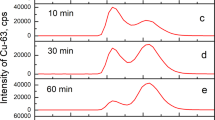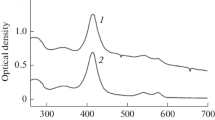Abstract
The hemolysis of red blood cells (RBC) induced by Cu(II) is modified by ceruloplasmin (Cp) and albumin. The time course of hemolysis for rabbit RBC by Cu(II) consisted of two parts, an induction period followed by a catastrophic lysis period. The induction period decreased and the lysis rate increased with increasing Cu(II) concentration. Cp or albumin, modified Cu(II) induced hemolysis, by increasing the duration of the induction period and decreasing the overall rate of hemolysis of RBC.
The catastrophic lysis period coincided with a sharp increase in the formation of metHb within the cell and in a rapid uptake of Cu(II). The presence of Cp led to an increase in the induction period prior to the rapid increase in metHb formation and in Cu(II) uptake.
Porcine Cp was prepared with either two or three nonprosthetic copper binding sties (sites where Cu(II) is easily removed by passing over Chelex-100). Cp with three nonprosthetic binding sites gave more protection than Cp with two. Likewise, albumin can be prepared with three and five nonprosthetic copper binding sites. The albumin with five sites gave more protection than the albumin with three sites.
Similar content being viewed by others
References
R. A. Lovstad,Int. J. Biochem. 14, 585–589 (1982).
G. Barnes and E. Frieden,Proceedings of the Fifth International Symposium on Trace Elements in Man and Animal, C. F. Mills, J. Bremmer, and J. K. Chester, eds., Commonwealth Agricultural Bureau, Farnham Royal, GB, 143–145 (1985).
J. M. Caffrey Jr., A. Dasmahapatra, H. A. Smith, K. Hede and E. Frieden,Biol. Trace Elem. Res. 11, 19–26 (1986).
H. A. Smith, A. K. Dasmahapatra, J. M. Caffrey, Jr., and E. Frieden,Comp. Biochem. Physiol. 91C (2) 301–306 (1988).
A. Zgirski and E. Frieden, unpublished data.
J. M. C. Gutteridge,Biochim et Biophys. Acta. 869, 119–127 (1986).
J. M. C. Gutteridge,FEBS 157, 37–40 (1983).
L. Michaelis,Biochem. Z. 234, 139–161 (1931).
A. A. Schilt,Analytical Applications of 1,10 Phenanthroline and Related Compounds, Pergamon, Oxford, p. 74 (1969).
R. E. Benecsh R. Benesch, and S. Yung,Anal. Biochem.,55, 245–248 (1973).
P. Hochstein, K. Sreekumar, and J. Stephen,The Red Cell, Liss, New York, pp. 669–681 (1978).
I. M. Goldstein H. B. Kaplan, H. S. Edelson, and G. Weissman,J. Biol. Chem. 154, 4040–4045 (1979).
J. W. Moffett, R. G. Zika and R. C. Petasne,Anal. Chim. Acta 175, 171 (1985).
G. Barnes and E. Frieden,Biochem. and Biophys. Res. Comm.,125, 157 (1984).
R. A. Ashmun, D. E. Hultquist, and J. E. Schultz,The Red Cell, Liss, New York, pp. 309–318 (1984).
Author information
Authors and Affiliations
Additional information
DuPont Undergraduate Research Program, Summer, 1988
Rights and permissions
About this article
Cite this article
Caffrey, J.M., Smith, H.A., Schmitz, J.C. et al. Hemolysis of rabbit erythrocytes in the presence of copper ions. Biol Trace Elem Res 25, 11–19 (1990). https://doi.org/10.1007/BF02990259
Received:
Accepted:
Issue Date:
DOI: https://doi.org/10.1007/BF02990259




